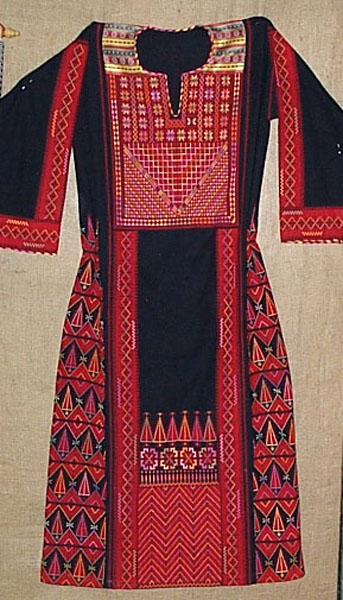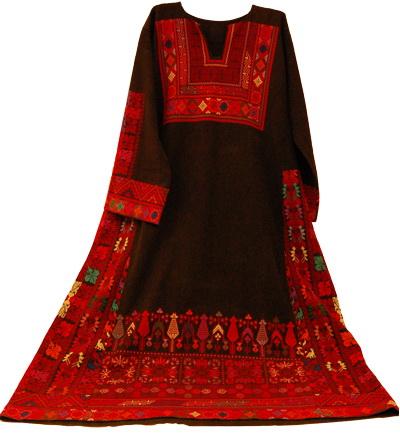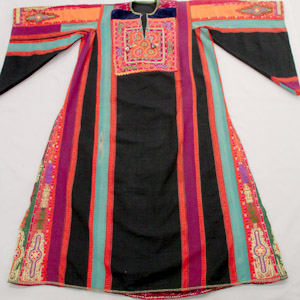Source(google.com.pk)
Free Palestine Clothing Biography
The wearing of clothing is exclusively a human characteristic and is a feature of most human societies. It is not known when humans began wearing clothes. Anthropologists believe that animal skins and vegetation were adapted into coverings as protection from cold, heat and rain, especially as humans migrated to new climates; alternatively, covering may have been invented first for other purposes, such as magic, decoration, cult, or prestige, and later found to be practical as well.
Clothing and textiles have been important in human history and reflects the materials available to a civilization as well as the technologies that it has mastered. The social significance of the finished product reflects their culture.
Textiles, defined as felt or spun fibers made into yarn and subsequently netted, looped, knit or woven to make fabrics, appeared in the Middle East during the late stone age.[1] From ancient times to the present day, methods of textile production have continually evolved, and the choices of textiles available have influenced how people carried their possessions, clothed themselves, and decorated their surroundings.[2]
Sources available for the study of the history of clothing and textiles include material remains discovered via archaeology; representation of textiles and their manufacture in art; and documents concerning the manufacture, acquisition, use, and trade of fabrics, tools, and finished garments. Scholarship of textile history, especially its earlier stages, is part of material culture studies.
he development of textile and clothing manufacture in prehistory has been the subject of a number of scholarly studies since the late 20th century.[5][6] These sources have helped to provide a coherent history of these prehistoric developments. Evidence suggests that human beings may have begun wearing clothing as far back as 100,000 to 500,000 years ago.[7]
Possible sewing needles have been dated to around 40,000 years ago.[8] The earliest definite examples of needles originate from the Solutrean culture, which existed in France from 19,000 BC to 15,000 BC. The earliest dyed flax fibers have been found in a prehistoric cave in the Republic of Georgia and date back to 36,000 BP.[9][10]
The earliest evidence of weaving comes from impressions of textiles and basketry and nets on little pieces of hard clay, dating from 27,000 years ago and found in Dolni Vestonice in the Czech Republic.
At a slightly later date (25,000 years) the Venus figurines were depicted with clothing.[11] Those from western Europe were adorned with basket hats or caps, belts worn at the waist, and a strap of cloth that wrapped around the body right above the breast. Eastern European figurines wore belts, hung low on the hips and sometimes string skirts.[6]
Archaeologists have discovered artifacts from the same period that appear to have been used in the textile arts: (5000 BC) net gauges, spindle needles and weaAlongside these developments were changes in the types and style of clothing produced. During the 1960s, had a major influence on subsequent developments in the industry.[55]
Textiles were not only made in factories. Before this that they were made in local and national markets. Dramatic change in transportation throughout the nation is one source that encouraged the use of factories. New advances such as steamboats, canals, and railroads lowered shipping costs which caused people to buy cheap goods that were produced in other places instead of more expensive goods that were produced locally. Between 1810 and 1840 the development of a national market prompted manufacturing which tripled the output’s worth. This increase in production created a change in industrial methods, such as the use of factories instead of hand made woven materials that families usually made.[56]
The vast majority of the people who worked in the factories were women. Women went to work in textile factories for a number of reasons. Some women left home to live on their own because of crowding at home; or to save for future marriage portions. The work enabled them to see more of the world, to earn something in anticipation of marriage, and to ease the crowding within the home. They also did it to make money for family back home. The money they sent home was to help out with the trouble some of the farmers were having. They also worked in the millhouses because they could gain a sense of independence and growth as a personal goal










Free Palestine Clothing Biography
The wearing of clothing is exclusively a human characteristic and is a feature of most human societies. It is not known when humans began wearing clothes. Anthropologists believe that animal skins and vegetation were adapted into coverings as protection from cold, heat and rain, especially as humans migrated to new climates; alternatively, covering may have been invented first for other purposes, such as magic, decoration, cult, or prestige, and later found to be practical as well.
Clothing and textiles have been important in human history and reflects the materials available to a civilization as well as the technologies that it has mastered. The social significance of the finished product reflects their culture.
Textiles, defined as felt or spun fibers made into yarn and subsequently netted, looped, knit or woven to make fabrics, appeared in the Middle East during the late stone age.[1] From ancient times to the present day, methods of textile production have continually evolved, and the choices of textiles available have influenced how people carried their possessions, clothed themselves, and decorated their surroundings.[2]
Sources available for the study of the history of clothing and textiles include material remains discovered via archaeology; representation of textiles and their manufacture in art; and documents concerning the manufacture, acquisition, use, and trade of fabrics, tools, and finished garments. Scholarship of textile history, especially its earlier stages, is part of material culture studies.
he development of textile and clothing manufacture in prehistory has been the subject of a number of scholarly studies since the late 20th century.[5][6] These sources have helped to provide a coherent history of these prehistoric developments. Evidence suggests that human beings may have begun wearing clothing as far back as 100,000 to 500,000 years ago.[7]
Possible sewing needles have been dated to around 40,000 years ago.[8] The earliest definite examples of needles originate from the Solutrean culture, which existed in France from 19,000 BC to 15,000 BC. The earliest dyed flax fibers have been found in a prehistoric cave in the Republic of Georgia and date back to 36,000 BP.[9][10]
The earliest evidence of weaving comes from impressions of textiles and basketry and nets on little pieces of hard clay, dating from 27,000 years ago and found in Dolni Vestonice in the Czech Republic.
At a slightly later date (25,000 years) the Venus figurines were depicted with clothing.[11] Those from western Europe were adorned with basket hats or caps, belts worn at the waist, and a strap of cloth that wrapped around the body right above the breast. Eastern European figurines wore belts, hung low on the hips and sometimes string skirts.[6]
Archaeologists have discovered artifacts from the same period that appear to have been used in the textile arts: (5000 BC) net gauges, spindle needles and weaAlongside these developments were changes in the types and style of clothing produced. During the 1960s, had a major influence on subsequent developments in the industry.[55]
Textiles were not only made in factories. Before this that they were made in local and national markets. Dramatic change in transportation throughout the nation is one source that encouraged the use of factories. New advances such as steamboats, canals, and railroads lowered shipping costs which caused people to buy cheap goods that were produced in other places instead of more expensive goods that were produced locally. Between 1810 and 1840 the development of a national market prompted manufacturing which tripled the output’s worth. This increase in production created a change in industrial methods, such as the use of factories instead of hand made woven materials that families usually made.[56]
The vast majority of the people who worked in the factories were women. Women went to work in textile factories for a number of reasons. Some women left home to live on their own because of crowding at home; or to save for future marriage portions. The work enabled them to see more of the world, to earn something in anticipation of marriage, and to ease the crowding within the home. They also did it to make money for family back home. The money they sent home was to help out with the trouble some of the farmers were having. They also worked in the millhouses because they could gain a sense of independence and growth as a personal goal
Free Palestine Clothing

Free Palestine Clothing

Free Palestine Clothing

Free Palestine Clothing

Free Palestine Clothing

Free Palestine Clothing

Free Palestine Clothing

Free Palestine Clothing

Free Palestine Clothing

Free Palestine Clothing

Free Palestine Clothing
No comments:
Post a Comment